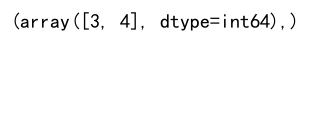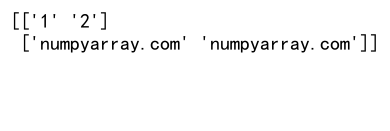Numpy Where函数的使用方法
参考:numpy where
Numpy 是一个功能强大的 Python 库,主要用于处理大型多维数组和矩阵。一个常用的功能是 numpy.where(),它是一个条件函数,用于从数组中选择元素。本文将详细介绍 numpy.where() 函数的使用方法,并提供多个示例代码以帮助理解。
1. numpy.where() 基本用法
numpy.where() 函数返回输入数组中满足给定条件的元素的索引。它的基本语法如下:
numpy.where(condition, [x, y])
condition:条件表达式。x:可选,满足条件时返回的值。y:可选,不满足条件时返回的值。
如果只提供条件,numpy.where() 将返回满足条件的元素的索引。如果同时提供了 x 和 y,它将返回一个数组,其中满足条件的位置将被 x 替换,不满足条件的位置将被 y 替换。
示例代码 1:基本索引
import numpy as np
arr = np.array([1, 2, 3, 4, 5])
result = np.where(arr > 3)
print(result)
Output:

示例代码 2:替换元素
import numpy as np
arr = np.array([1, 2, 3, 4, 5])
result = np.where(arr > 3, 'numpyarray.com', arr)
print(result)
Output:

2. 使用 numpy.where() 进行复杂条件判断
numpy.where() 可以结合多个条件来进行更复杂的数组元素选择。可以使用逻辑运算符如 &(和)、|(或)等。
示例代码 3:多条件判断
import numpy as np
arr = np.array([1, 2, 3, 4, 5, 6, 7, 8, 9])
result = np.where((arr > 2) & (arr < 8), 'numpyarray.com', arr)
print(result)
Output:

3. 结合其他 numpy 函数使用
numpy.where() 可以与其他 numpy 函数结合使用,例如 np.sum()、np.mean() 等,以实现更复杂的数组操作。
示例代码 4:结合 np.sum()
import numpy as np
arr = np.array([[1, 2], [3, 4]])
result = np.where(arr > 2, arr, 0)
sum_result = np.sum(result)
print(sum_result)
Output:

示例代码 5:使用 np.mean() 计算条件平均值
import numpy as np
arr = np.array([1, 2, 3, 4, 5])
result = np.where(arr > 2, arr, 0)
mean_result = np.mean(result)
print(mean_result)
Output:

4. 在多维数组中使用 numpy.where()
numpy.where() 也适用于多维数组,可以用来查询和替换满足条件的元素。
示例代码 6:多维数组索引
import numpy as np
arr = np.array([[1, 2], [3, 4]])
result = np.where(arr > 2)
print(result)
Output:

示例代码 7:多维数组替换
import numpy as np
arr = np.array([[1, 2], [3, 4]])
result = np.where(arr > 2, 'numpyarray.com', arr)
print(result)
Output:

5. 使用 numpy.where() 处理复杂逻辑
在处理复杂的数据逻辑时,numpy.where() 可以嵌套使用,以处理多层条件判断。
示例代码 8:嵌套使用 numpy.where()
import numpy as np
arr = np.array([1, 2, 3, 4, 5])
result = np.where(arr > 3, 'numpyarray.com', np.where(arr < 2, 'numpyarray.com', arr))
print(result)
Output:

6. 性能考虑
使用 numpy.where() 时,尤其在处理大型数组时,需要考虑性能问题。numpy.where() 是基于 C 语言实现的,因此它的执行速度通常比纯 Python 代码快很多。
示例代码 9:性能测试
import numpy as np
import time
large_arr = np.random.randint(1, 100, size=(1000, 1000))
start_time = time.time()
result = np.where(large_arr > 50, 'numpyarray.com', large_arr)
end_time = time.time()
print("Execution time: ", end_time - start_time)
Output:

7. 结论
numpy.where() 是一个非常有用的函数,可以在数据分析和数据处理中广泛使用。通过上述示例,我们可以看到 numpy.where() 在数组操作中的灵活性和强大功能。无论是进行简单的条件判断还是处理复杂的数组逻辑,numpy.where() 都是一个非常有效的工具。
 极客笔记
极客笔记